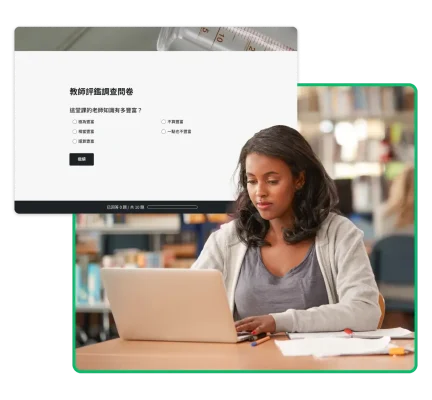
收集坦誠、優質的學生意見回饋是提升教學品質的有效方法,也是追求成長、為學生樹立榜樣的好機會。教師評鑑調查問卷不僅提供了一個讓學生表達意見的管道,還能幫助老師改善教學方式並瞭解實際學習成果與期望成果之間的差距。
本文將探討教師評鑑調查問卷應包含哪些內容,以及為什麼把它設計好那麼重要。您將會瞭解如何使用教師評鑑表單改善教育成果,並對您的職涯發展帶來幫助。
何謂教師評鑑?
教師評鑑是指對老師的教學表現及成效進行評估的程序。
教師評鑑可以採取觀察的形式,例如讓行政主管或其他老師到教室觀察課堂的進行。除了課堂觀察以外,這些觀察員也會使用教師評鑑調查問卷來量化追蹤教師的表現。
舉例來說,高中校長可能會定期發送調查問卷詢問學生的意見回饋。
為什麼要做教師評鑑?
如果不試圖瞭解哪裡可以改善,您永遠都無法提升教學品質。 教師評鑑的目標 (尤其是以學生的觀點來看老師的表現) 在於獲得有實際行動價值的洞見。
證明教學成效
教師評鑑可以評量您的教學成效,幫助您持續使用有效的策略,並針對無法引起學生共鳴的部分做出改善。
事實上,史丹佛大學的一項研究發現,在完成教師評鑑的當年和往後的幾年,都能看見老師教學成效持續進步。
然而,教師評鑑嘉惠的對象可不只有學生,這些數據資料還能成為老師持續成長的證明,進而促進他們的職涯發展,例如,學生優良的學習成果及對老師的正面評價,都能成為老師獲得升等和聘任的助力。
創造更好的在學體驗
找到有待彌補的工具、資源和資金缺口,以便改善學生的理解和課堂參與度。雖然考試成績往往是衡量學生學習成果的重要指標,但成績不見得能反映教學的有效度。教師評鑑可以提供這項資訊。
舉例來說,假設有一名學生在某堂課的成績很好,但當被問到「您對這堂課的教材內容有多理解?」時,他卻經常回答「不太理解」,這樣老師就會知道該名學生雖然應試能力很好,但是對課堂教材的理解度卻需要加強。
這樣一來,老師可能需要花多點時間精力協助學生掌握重要觀念,並減少填鴨式記憶的占比。
為老師找到持續學習的機會
教師評鑑能用來辨識出老師在專業上的成長需求,以便尋找適當的訓練或資源來加強教學方法。例如,學校可能會透過學生調查問卷發現課堂教材的設計經常沒有考慮到身心障礙學生的需要,這就表示老師可能需要接受相關訓練,使他們具備設計無障礙教材的能力。
備註:持續學習對老師來說是很重要的,許多政府和機構也會制定相關規範和要求。藉由定期更新自己的知識和技能,各領域的老師才能因應新興的教學需求。

適合詢問學生的 14 道教師評鑑問題
如果您需要參考教師評鑑的範例,以下列舉幾個教師評鑑調查問卷中最重要的問題。
- 您的教師是否具有豐富的專業知識?
- 極為豐富
- 相當豐富
- 還算豐富
- 略為淺薄
- 毫無知識
- 這名老師在講解課程教材時,講得有多清楚?
- 極為清楚
- 非常清楚
- 還算清楚
- 不太清楚
- 毫不清楚
- 您如何評價這名老師對教材的掌握程度?
- 極好
- 很好
- 還算不錯
- 不太好
- 一點都不好
- 當學生有疑問時,這名老師回答得多好?
- 極好
- 很好
- 還算不錯
- 不太好
- 完全不好
- 課堂作業的內容是太簡單、太困難或適中?
- 非常簡單
- 非常容易
- 適中
- 非常困難
- 過於困難
- 這名老師派的回家作業對於您對教材的理解多有幫助?
- 極有幫助
- 很有幫助
- 還算有幫助
- 沒什麼幫助
- 完全沒幫助
- 以下陳述的真實性有多高?我從這個課程當中學到了很多關於本課程主題的知識。
- 極為真實
- 相當真實
- 還算真實
- 不太真實
- 極不真實
- 向老師提出問題或疑慮是否容易?
- 極為容易
- 相當容易
- 還算容易
- 不太容易
- 非常不容易
- 這名老師把課程要求說明得多清楚?
- 極為清楚
- 非常清楚
- 還算清楚
- 不太清楚
- 毫不清楚
- 這名老師的教學進度有多符合課程大綱?
- 極為符合
- 很符合
- 還算符合
- 不太符合
- 完全不符合
- 這名老師在講解課程教材時,速度是否太快、太慢,還是適中?
- 快得過頭
- 太快
- 適中
- 太慢
- 慢得過頭
- 您最喜歡/最不喜歡本課程的哪個部分?
- 這名老師用了哪些方式讓本課程更引人入勝?
- 您有什麼話想對這名老師說嗎?
備註:第 12-14 道問題為開放式問題,也就是學生必須用自己的話回答。
教學有效性問題
這包括「這名老師在講解課程教材時,講得有多清楚?」以及「當學生有疑問時,這名老師回答得多好?」這類問題。您可以利用收到的回覆來判定上課方式及回家作業是否有達到預期的資訊傳遞效果。
如果您的評鑑不是採匿名形式進行,那麼您也可以順便追蹤學生的成績和出席率。如果把老師教學有效性評得較低分的學生通常是出席率低的學生,那麼您或許可以先嘗試提升出席率或多提供一些課外學習資源作為初步解決方案。
學生成長發展問題
評量學生的學習效果能讓您瞭解他們的發展狀況,您可以問的問題包括:
- 課堂作業的內容是太簡單、太困難或適中?
- 這名老師派的回家作業對於您對教材的理解多有幫助?
- 以下陳述的真實性有多高?「我從這個課程當中學到了很多關於本課程主題的知識。」
您也可以考慮詢問關於課程調整的問題。每個學生都不一樣,而有個別化教育計畫需求或因課外安排而無法按時上課的特殊學生,可能會需要透過課程調整來跟上其他人的步伐。
課堂管理問題
想要瞭解老師管理課堂的能力,您需要問像「這名老師用了哪些方式讓本課程更引人入勝?(開放式問題)」和「這名老師在講解課程教材時,速度是否太快、太慢,還是適中?」這類問題。
優良的課堂管理有助於營造適合學生學習和成長的環境,然而不僅如此。有效的課程管理也能夠改善教師的留任率。
根據美國智庫 RAND 的一項研究顯示,壓力大是公立學校老師提早離職最普遍的原因。優良的課堂管理能打造有效又冷靜的學習空間,有助減輕學生和老師的壓力。
這些問題的回覆能夠幫助老師回頭看看自己的管理能力,並反思自己在課堂中的情緒和感受。
教師評鑑的五大挑戰和侷限
教師評鑑不是完美的衡量指標,它的缺點需要您透過變通來克服。以下為幾個您必須知道的常見挑戰,以及解決這些問題的訣竅。
1. 有些學生不願意參與
有些學生就是不願意參與教師評鑑,可能是因為:
- 課程已到尾聲或學期即將結束,因此心不在焉
- 他們只想專心念書,尤其如果評鑑是在期末考期間進行的話
- 純粹不喜歡填寫問卷所以拒絕作答
即使您將調查問卷設為獲得學分的必要條件,也可能會適得其反。有些學生可能會隨便作答,只要有寫完就好,或因為不滿被強制參與而給出較刻薄的回覆。我們建議您把學生的缺席率列入考慮,並且讓他們自己找時間慢慢填寫。
2. 匿名或記名調查問卷
您必須在匿名或記名調查問卷之間做選擇,這兩種方式各自有其優缺點。記名調查問卷可能會降低學生如實回答的可能性。學生可能會怕遭到差別待遇,或不希望您連繫他詢問更多問題。
完全匿名的調查問卷較有可能收集到坦白的回覆,甚至提升學生的參與率。光是能鼓勵學生坦白回答,就使得匿名調查問卷具備較大優勢。
可惜的是,雖然完全匿名的調查問卷結果比較準確,但卻無法幫助您判斷某個離群值是否值得參考。例如,您將無法移除曾遭懲處或出席率低的學生的回覆。
3. 調查問卷篇幅控制
調查問卷的內容越豐富全面,越能夠收集到詳細而具行動價值的意見回饋,但也可能會使學生感到疲勞。當面對一長串的問題時,學生可能會倉促作答、提供不正確的回覆,或中途放棄,而這些情況都會嚴重影響調查問卷的品質和成效。
為了克服上述問題,您在設計評鑑問卷的時候,要記得把年級、能力和您的目標都考慮進去。舉例來說,高中生能保持專注的時間通常比研究生短,這表示您必須根據年齡和發展程度來決定適合的問卷長度和內容。
除此之外,簡短、重點明確且只針對關鍵教學實務的調查問卷也能夠促進學生專注思考,而提供更有意義的回覆,不論他們的年齡和程度為何。因此,您的問卷內容應該環繞在您最希望改善或評估的教學面向,而且把問題設計得清楚而簡單永遠是上策。
4. 評鑑週期不一致
有些機構並不會按時規律地進行教師評鑑,這其實會讓追蹤教師成長和發展的工作更加困難。
在理想的情況下,每堂課結束後都應該做教師評鑑,而每個學期的評鑑問卷內容也應該保持一致,因為如果問卷內容變動太大,就很難把調查結果與過去的資料比較以看出趨勢變化。
5. 固有偏見
根據教育領域雜誌《高等教育內部》(Inside Higher Ed) 指出,教師評鑑可能「面臨性別偏見的干擾,包括學生對女性教授進行的評鑑」,也可能受到其他偏見的影響,包括:
- 個人偏見:學生可能因為個人因素而特別喜歡或討厭某一位老師
- 種族偏見:學生對教學成效的感受可能受到老師的種族背景影響
- 學科偏見:學生對教學成效的感受可能受到科目本身的影響
針對消除偏見,美國教育期刊《高等教育評估與評鑑》建議多管齊下,包括聘請獨立教育評估機構、與學生進行面談、讓專家進行課堂觀察,並讓同儕審查上課教材及調查問卷分數。
如何使用教師評鑑表單
想知道學生對您的教學和課程有什麼想法,最佳途徑就是直接詢問他們,而教師評鑑調查問卷是最簡單方便的工具。
教師評鑑調查問卷不僅提供學生一個發聲管道,同時也能幫助您發現需要注意的趨勢和問題。
準備好要開始了嗎?以下是透過教師評鑑調查問卷收集學生意見回饋的四個步驟。
解釋調查問卷的宗旨和目標
花點時間說明您為什麼要這份問卷給學生,讓他們知道您會如何看待並使用這些資料,以及您非常希望他們能夠敞開心胸坦誠回答。
請確保您在評鑑問卷中詳細闡明您個人的教學目標,例如除了自己追求進步以外,您也希望幫助學生進步。您也應該事先告訴學生他們是否能選擇匿名回覆,以及是否有其他人 (如系主任或其他老師) 能看到他們的填寫結果。
范登堡大學教學中心也建議老師在課程大綱中表明將會進行意見調查。這樣除了強調課程對意見回饋的重視以外,也能促使學生更加留意他們在課堂上的體驗,如此一來,他們才不會在毫無準備的情況下收到教師評鑑調查問卷而隨便回答。
提出正確的問題
那麼,要怎麼知道該問那些問題,才能獲得有價值的學生意見回饋呢?首先,您應該先思考您希望從教師評鑑問卷調查獲得什麼資訊。
- 您是想知道學生對您教學風格的看法,還是學生是否覺得像您提問很自在?
- 您想要先瞭解學生對於課程的作業量、上課步調和整體結構的感覺如何,然後再進一步詢問關於教學方式的問題嗎?(我們的課程評鑑範本就是為此設計的。)
認真思考哪些資訊能夠幫助您加強教學方式及師生關係。為了讓您的提問發揮最大效果,建議您適度變換題型,並且納入一些開放式問題,用文字方塊收集非結構化的回覆。
當您讓學生用自己的話回答,也就是讓他們有機會針對問卷中遺漏的任何事項提出意見。雖然開放式問題有其好處,但請務必確保您的調查問卷內容以封閉式問題為主,因為填寫開放式問題很耗精神和時間,別讓忙碌的學生望而生畏。
判斷趨勢並根據資料做出改變
評估學生的意見回饋並不容易,請務必保持開放的態度並觀察資料中的趨勢,以識別需要改善之處。
例如,假設資料顯示有 80% 的學生認為某個作業很困難,您應該仔細思考到底是說明方式、評分標準,還是教學內容需要調整。
設定未來可以參考的基準
建議您讓教師評鑑問卷調查成為常態,固定在課程結束時進行一次。您甚至可以考慮在學期中舉辦一次,這樣您就能夠在課程結束之前發現並解決問題,然後將學期末的調查結果拿來與學期中的比較。這種比較是評鑑工作很重要的一部分,除了可以顯示出進步的軌跡以外,還有助於設定下次的評鑑目標。

更多教師評鑑範例和資源
做問卷調查是讓教師評鑑更充實而豐富的做法之一。然而,不是只有學生可以評鑑老師,老師也可以評鑑學生,例如美國大學的通用申請系統就會讓老師評估其學生是否已經具備上大學的程度。
歡迎使用我們可自訂的教育類調查問卷範本立即寄出您的調查問卷,或您也可以進一步瞭解 SurveyMonkey 能如何協助您建立教師評鑑評量指標、收集學生的意見回饋並改善教室的秩序和環境。
探索更多資源

適合您職位的解決方案
SurveyMonkey 可協助您更有效地完成工作。探索如何藉由制定成功策略、產品、體驗等來發揮更大影響力。

利用線上評量表單收集可付諸行動的意見回饋
線上建立並自訂評量表單。輕鬆收集結構化的意見反應、評估績效並做出以資料為依據的決策。

托兒服務登記表範本
使用托兒所報名表範本,簡化托兒所入學流程。使用直覺式 SurveyMonkey 表單建立器,根據您的需求自訂範本。

校友登記表範本
使用校友登記表範本,與貴校校友保持聯絡。使用直覺式表單建立器,根據您的需求自訂表單。